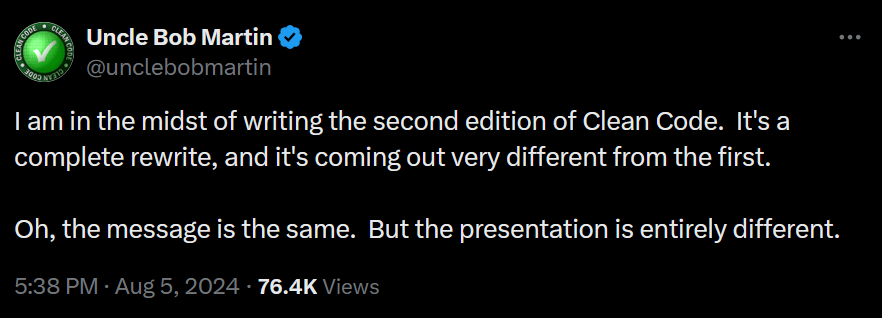this post was submitted on 10 Aug 2024
588 points (97.3% liked)
Programmer Humor
19564 readers
643 users here now
Welcome to Programmer Humor!
This is a place where you can post jokes, memes, humor, etc. related to programming!
For sharing awful code theres also Programming Horror.
Rules
- Keep content in english
- No advertisements
- Posts must be related to programming or programmer topics
founded 1 year ago
MODERATORS
you are viewing a single comment's thread
view the rest of the comments
view the rest of the comments

I agree with him on this point. Sounds similar to how it’s in Java, and I hate it. I always wrap my exceptions in a RuntimeExceptions because of this.
I disagree with him the rest of the post. The job of the programmer is to communicate the intent of the program. Both for others and for yourself. The language provides the tools to do so. If a value is intended to be nullable, then I would like to communicate this intent. I think it’s good when a language provides this tool.
Tests don’t communicate the intent of the code. Tests can’t perfectly validate all the possible edge cases of the system either.
Checked exceptions are powerful but misunderstood. Exception types are a useful part of the facade to a module - they express to a caller how it can go wrong even if used correctly.
Runtime exceptions are typically there to express contract-breaking by callers; although as an alternative return mechanism I've seen them used to simplify the inner workings of some frameworks.
I think they get a bad rep because there aren't a ton of good examples of how to use them - even the java classpath had some egregious misuse initially that helped turn people off the key ideas.
Imo, if a method require the caller to do error handling, then that should be part of the return value. For example, use optional or either. Exceptions shouldn’t be part of any expected control flow (like file not found). Exceptions is an emergency panic button.
The problem is that most languages with exceptions treat that as the idiomatic error mechanism. So checked exceptions were invented, essentially, to do exactly what you say: add the exception type to the function signature.
Having separate errors-as-return-values and unwinding-for-emergencies is a much more recent trend (and, IMO, an obviously good development).
I'm not sure why it's "obviously" good to move from one mechanism to two: as a user I now have to categorise every path to work out which is appropriate.
What I said was less about adding to a function signature than it was about adding to a facade - that is, a system boundary, although the implementation may be the same depending on language. People typically use exceptions pretty badly - a function signature with a baggage-train of internal exceptions that might be thrown by implementation guts is another antipattern that gives the approach a bad rep. Errors have types too (or they should have), and the typical exception constructor has a wrapper capability for good reason.
I should have stressed the "opinion" part of "IMO". What I mean is that, when I read this, it struck me immediately as being exactly correct: https://joeduffyblog.com/2016/02/07/the-error-model/
That's a cracking article.
My own use of jvm errors tends to follow the same kinds of patterns: I think the major fault with that model is having RuntimeException as a subclass of Exception, because it's really intended for abandonment-style errors. (The problem is that lots of people use it instead as an exception system in order to cut down on boilerplate.)
I find it eye-opening that the author prefers callsite annotation with
try(although I'm not going to argue with their experience at the time). I can see this being either "no big deal" or even "a good thing" to Rust users in particular - mutability and borrowing annotations at both callsite and definition aren't required to make the language work afaict (your ide will instantly carp if you miss 'em out) but the increased programmer visibility is typically seen as a good thing. (Perhaps this is down to people largely reviewing PRs in a browser, I dunno.) Certainly there's tons of good food for thought there.I'm a Rust fan, and I do think they eventually struck a pretty good "visibility vs noise" balance with
?(which was highly controversial at the time).I'm coming around to it.